Feed Curves for Controlling Ring Rolling Stability in Large-Scale Flat Ring Rolling Process
Abstract
1. Introduction
2. Analysis of Ring Rolling Stability
2.1. Roundness Error Analysis
2.2. Eccentricity Analysis
2.3. Vibration Analysis
2.4. Division of Rolling Stages Based on Rolling Stability
3. Radial Feed Curve Design
3.1. Radial Feed Curve for Different Rolling Stages
3.2. Coordinated Radial Feed Curve Design
3.3. Stability Rolling Feed Curves
- Region I is the stable rolling region. The roundness error, eccentricity and vibration in this region are all the minimum areas, so region I is determined by the minimum areas of roundness error, eccentricity and vibration.
- Region II is the defect region with high vibration. In addition to vibration, roundness error and eccentricity in this region are the minimum areas, so the rolling process in this region has the phenomenon of high vibration. Region II is determined by the common area of roundness error and eccentricity.
- Region III is the defect region with a serious ellipse. This region includes only the minimum areas of vibration and eccentricity, so the ring shape in the rolling process is more elliptical under the radial feed curve designed based on this region.
- Region IV is the defect region with strong eccentricity and high vibration. Because this region is only within the minimum roundness error area, the rolling process in this region has the characteristics of strong eccentricity and high vibration.
- Region V is the defect region with a serious ellipse and strong eccentricity. Due to this region being determined by the minimum of vibration, the roundness error and eccentricity value are not guaranteed to be minimum, so a serious ellipse and strong eccentricity are inevitable in this region.
- Region VI is the defect region with a serious ellipse tendency and high vibration tendency. Only eccentricity in this region is within the minimum eccentricity area, so the ring in this region has a serious ellipse and high vibration.
- Region VII is the instability rolling region. This region is outside of all minimum areas, which causes instability in the rolling process.
4. Verification of Feed Curve Designed by Stability Rolling Region
4.1. Verification of Stability Rolling Region
4.2. Verification of Feed Curve
5. Conclusions
- The roundness error, eccentricity and vibration of the rolled ring easily occur during large-scale ring rolling. The mechanism of roundness error and eccentricity is that the bending moment of the ring cross-section in the radial deformation zone is greater than the ultimate bending moment, which changes the radius and curvature of the ring in the circumferential direction. The vibration is caused by the loss of circularity of the ring, which prevents the guide roll from contacting the ring, thus generating a deflecting moment, which deflects the ring around the center of the mandrel.
- The coordination of the different rolling stages influences the maximum value of the roundness error, eccentricity and vibration during rolling. The results of the analytical analysis and the numerical simulations are in agreement, and both indicate that the ring rolling stability is good at the beginning of rolling and that the outer diameter of the ring should be increased rapidly. Subsequently, the ring rolling stability increases rapidly such that the later stages of rolling need to be rolled slowly.
- Based on the rolling map established by superposing the minimum contour lines in the maximum roundness error, eccentricity and vibration response surface, a stable rolling region is generated to determine the radial feed curve, and rolling defects of different rolling regions are revealed. Moreover, FE simulation results show that the values of roundness error, vibration and eccentricity per revolution for different optimized radial feed curves in the stable rolling region are all below the minimum values that determine the stable rolling region, which demonstrates the feasibility of the designed radial curve based on the stable rolling region.
- A feed curve in the stable rolling region was selected to carry out a production trial and FE simulations for the ring rolling of 2219 aluminum alloy with a diameter of 5 m. Their results show that the roundness error, eccentricity and vibration obtained from the numerical simulation are basically the same as those from the production trial, and the mechanical machining amounts are all below the maximum value, indicating that the feed curve designed based on the stable rolling region can meet the geometry requirements of a large-scale ring.
Author Contributions
Funding
Institutional Review Board Statement
Informed Consent Statement
Data Availability Statement
Conflicts of Interest
References
- Eruç, E.; Shivpuri, R. A Summary of Ring Rolling Technology—I. Recent Trends in Machines, Processes and Production Lines. Int. J. Mach. Tools Manuf. 1992, 32, 379–398. [Google Scholar] [CrossRef]
- Eruç, E.; Shivpuri, R. A Summary of Ring Rolling Technology—II. Recent Trends in Process Modeling, Simulation, Planning, and Control. Int. J. Mach. Tools Manuf. 1992, 32, 399–413. [Google Scholar] [CrossRef]
- Hua, L.; Pan, L.; Lan, J. Researches on the Ring Stiffness Condition in Radial–Axial Ring Rolling. J. Mater. Process. Technol. 2009, 209, 2570–2575. [Google Scholar] [CrossRef]
- Wang, M.; Yang, H.; Sun, Z.C.; Guo, L.G. Analysis of Coupled Mechanical and Thermal Behaviors in Hot Rolling of Large Rings of Titanium Alloy Using 3D Dynamic Explicit FEM. J. Mater. Process. Technol. 2009, 209, 3384–3395. [Google Scholar] [CrossRef]
- Yang, H.; Zhan, M.; Liu, Y.L.; Xian, F.J.; Sun, Z.C.; Lin, Y.; Zhang, X.G. Some Advanced Plastic Processing Technologies and Their Numerical Simulation. J. Mater. Process. Technol. 2004, 151, 63–69. [Google Scholar] [CrossRef]
- Zhou, G.; Hua, L.; Lan, J.; Qian, D.S. FE Analysis of Coupled Thermo-Mechanical Behaviors in Radial–Axial Rolling of Alloy Steel Large Ring. Comput. Mater. Sci. 2010, 50, 65–76. [Google Scholar] [CrossRef]
- Yeom, J.T.; Kim, J.H.; Park, N.K.; Choi, S.S.; Lee, C.S. Ring-Rolling Design for a Large-Scale Ring Product of Ti–6Al–4V Alloy. J. Mater. Process. Technol. 2007, 187–188, 747–751. [Google Scholar] [CrossRef]
- Zhou, P.; Zhang, L.; Gu, S.; Ruan, J.; Teng, L. Mathematic Modeling and FE Simulation of Radial-Axial Ring Rolling Large L-Section Ring by Shape Axial Roll. Int. J. Adv. Manuf. Technol. 2014, 72, 729–738. [Google Scholar] [CrossRef]
- Guo, L.; Yang, H. Towards a Steady Forming Condition for Radial–Axial Ring Rolling. Int. J. Mech. Sci. 2011, 53, 286–299. [Google Scholar] [CrossRef]
- Lee, K.-H.; Kim, B.-M. Advanced Feasible Forming Condition for Reducing Ring Spreads in Radial–Axial Ring Rolling. Int. J. Mech. Sci. 2013, 76, 21–32. [Google Scholar] [CrossRef]
- Zhu, S.; Yang, H.; Guo, L.; Hu, L.; Chen, X. Research on the Effects of Coordinate Deformation on Radial-Axial Ring Rolling Process by FE Simulation Based on in-Process Control. Int. J. Adv. Manuf. Technol. 2014, 72, 57–68. [Google Scholar] [CrossRef]
- Xu, W.; Zhou, X.; Long, J.; Wang, Q.; Yang, X. Feeding Interval Design Considering Multiconstraints in Flat Ring Rolling Process. Int. J. Adv. Manuf. Technol. 2015, 81, 219–229. [Google Scholar] [CrossRef]
- Berti, G.A.; Quangliato, L.; Monti, M. Set-up of radial–axial ring-rolling process: Process worksheet and ring geometry expansion prediction. Int. J. Mech. Sci. 2015, 99, 58–71. [Google Scholar] [CrossRef]
- Liang, L.; Guo, L.; Yang, J.; Zhang, H. Formation mechanism and control method of multiple geometric defects in conical-section profiled ring rolling. J. Mater. Process. Technol. 2022, 306, 117628. [Google Scholar] [CrossRef]
- Liang, L.; Guo, L. Advanced feeding strategy driven by staged growth velocity for groove-section profiled ring rolling. Int. J. Adv. Manuf. Technol. 2022, 81, 907–921. [Google Scholar] [CrossRef]
- Davey, K.; Ward, M.J. A Practical Method for Finite Element Ring Rolling Simulation Using the ALE Flow Formulation. Int. J. Mech. Sci. 2002, 44, 165–190. [Google Scholar] [CrossRef]
- Davey, K.; Ward, M.J. An ALE Approach for Finite Element Ring-Rolling Simulation of Profiled Rings. J. Mater. Process. Technol. 2003, 139, 559–566. [Google Scholar] [CrossRef]
- Kang, B.-S.; Kobayashi, S. Preform Design in Ring Rolling Processes by the Three-Dimensional Finite Element Method. Int. J. Mach. Tools Manuf. 1991, 31, 139–151. [Google Scholar] [CrossRef]
- Hu, Z.M.; Pillinger, I.; Hartley, P.; McKenzie, S.; Spence, P.J. Three-Dimensional Finite-Element Modelling of Ring Rolling. J. Mater. Process. Technol. 1994, 45, 143–148. [Google Scholar] [CrossRef]
- Han, X.; Hua, L.; Zhou, G.; Lu, B.; Wang, X. FE Simulation and Experimental Research on Cylindrical Ring Rolling. J. Mater. Process. Technol. 2014, 214, 1245–1258. [Google Scholar] [CrossRef]
- Hu, Y.; Liu, D.; Yang, Y.; Wang, J.; Liu, Y.; Zhu, X. Multi-objective optimization of cavity design for GH4738 superalloy profle ring rolling process based on FEM and RSM. Int. J. Adv. Manuf. Technol. 2022, 123, 2929–2940. [Google Scholar] [CrossRef]
- Quagliato, L.; Berti, G.A. Mathematical Definition of the 3D Strain Field of the Ring in the Radial-Axial Ring Rolling Process. Int. J. Mech. Sci. 2016, 115–116, 746–759. [Google Scholar] [CrossRef]
- Hua, L.; Deng, J.; Qian, D.; Lan, J.; Long, H. Modeling and Application of Ring Stiffness Condition for Radial-Axial Ring Rolling. Int. J. Mach. Tools Manuf. 2016, 110, 66–79. [Google Scholar] [CrossRef]
- Cleaver, C.J.; Allwood, J.M. Curvature Development in Ring Rolling. J. Mater. Process. Technol. 2019, 267, 316–337. [Google Scholar] [CrossRef]
- Lv, N.; Liu, D.; Hu, Y.; Yang, Y.; Wang, J. Multi-objective optimization of parametric design for profile ring rolling process based on residual stress control. Int. J. Adv. Manuf. Technol. 2022, 199, 6613–6631. [Google Scholar] [CrossRef]
- Yi, Z.; Li, X.; Chang, S.; Cao, Q. Flow Stress Constitutive Equation of 2219 Aluminum Alloy During Hot Compression. Mater. Mech. Eng. 2018, 42, 53–56. [Google Scholar] [CrossRef]
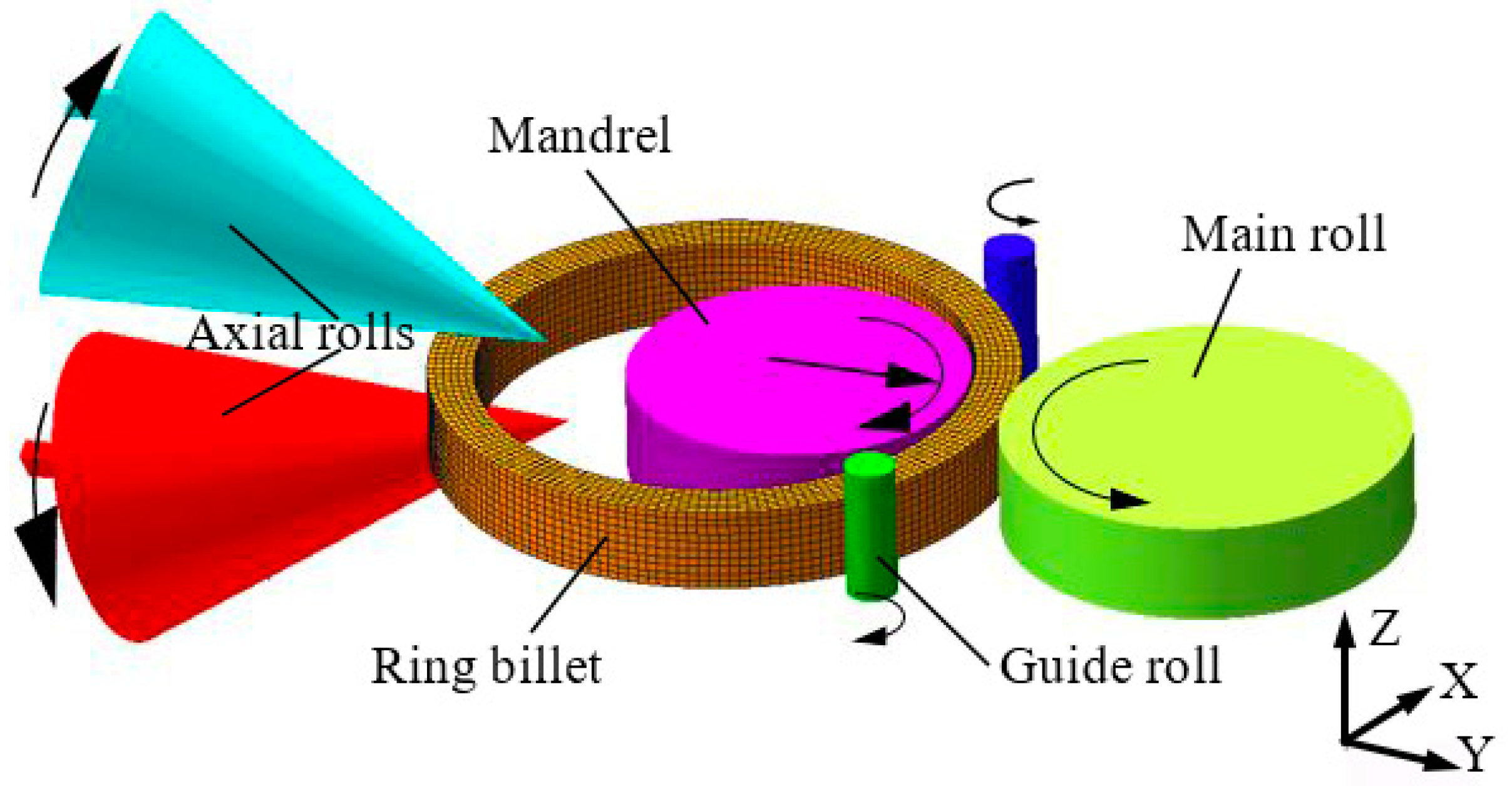
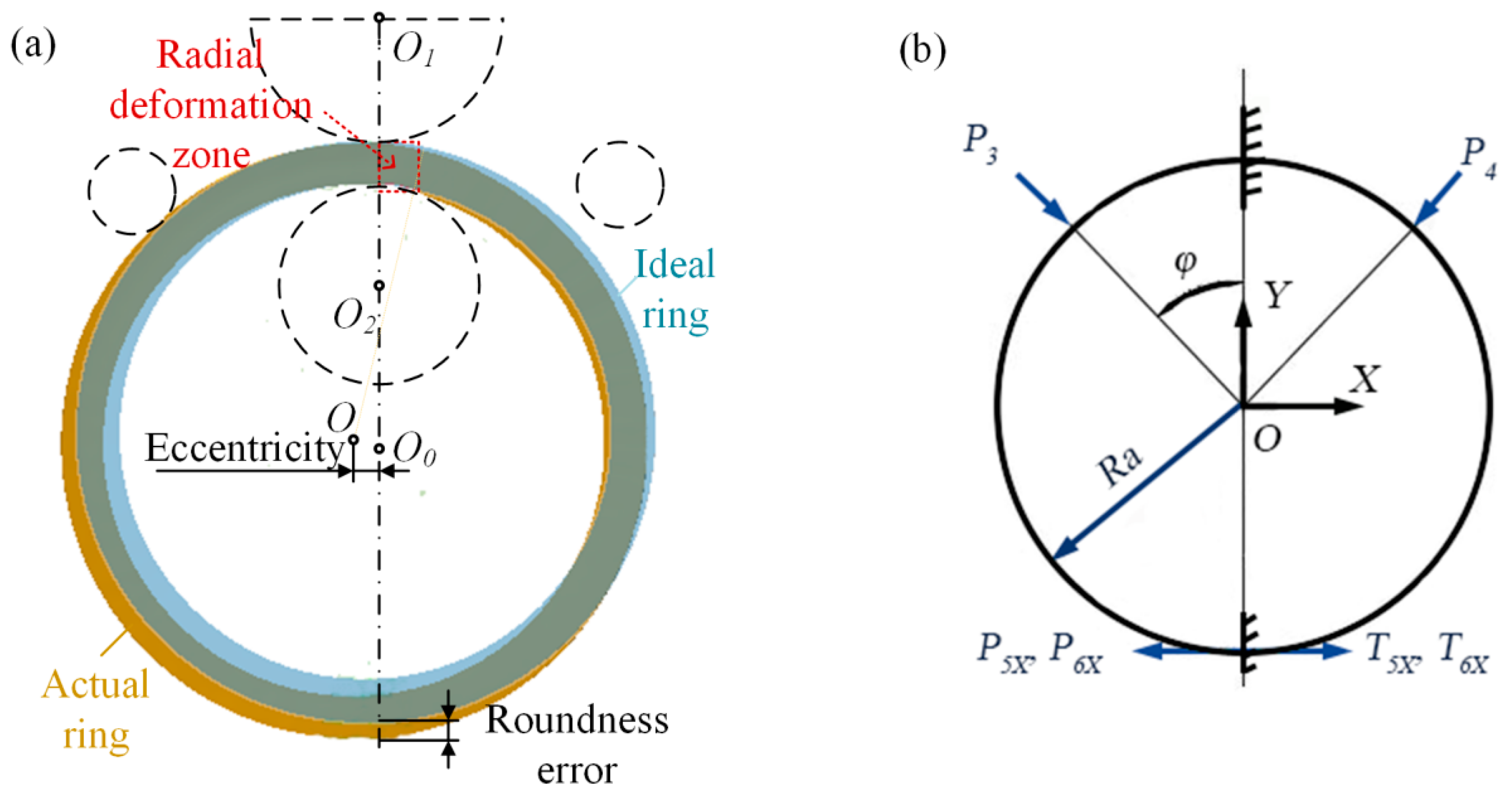

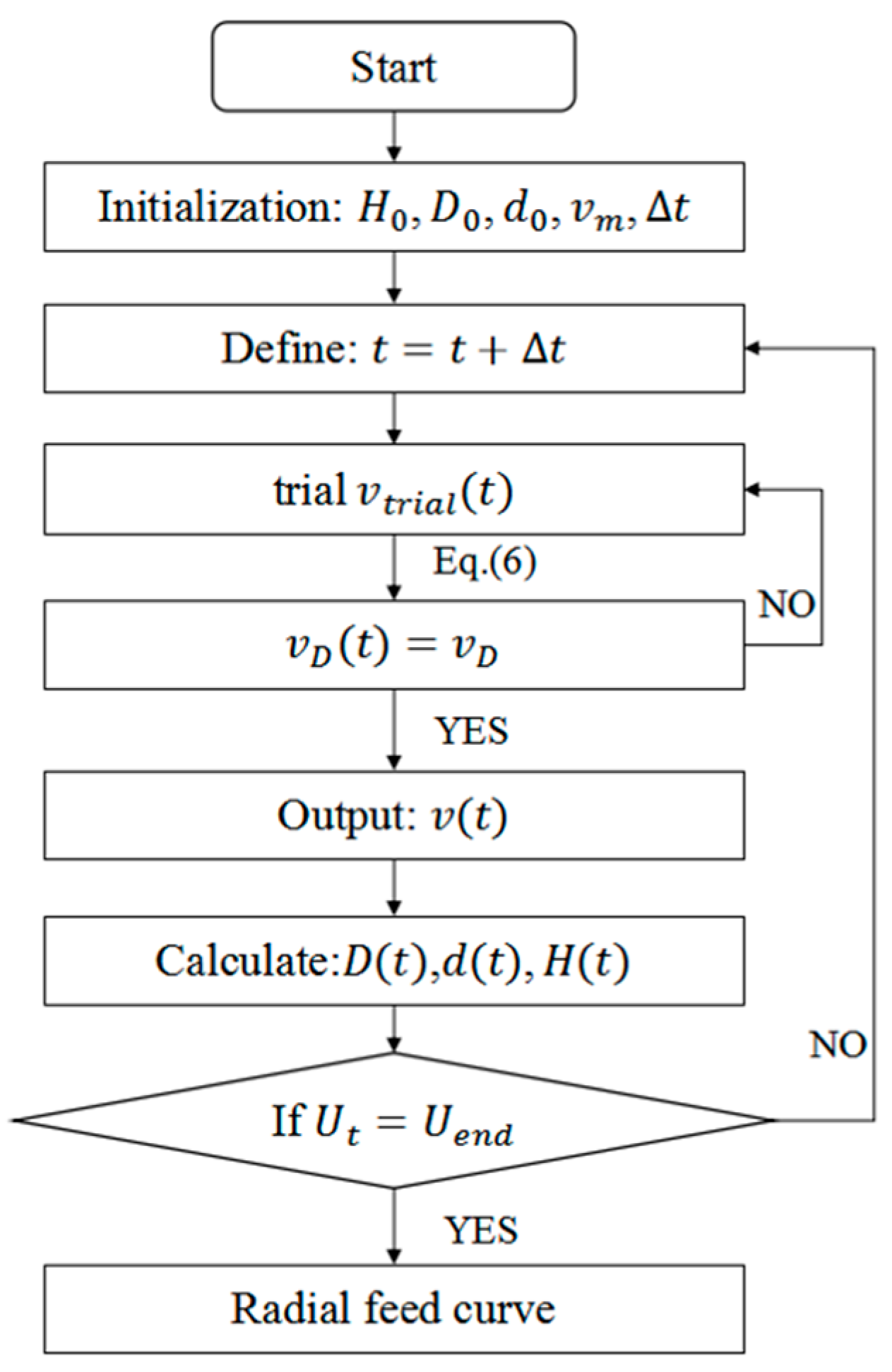
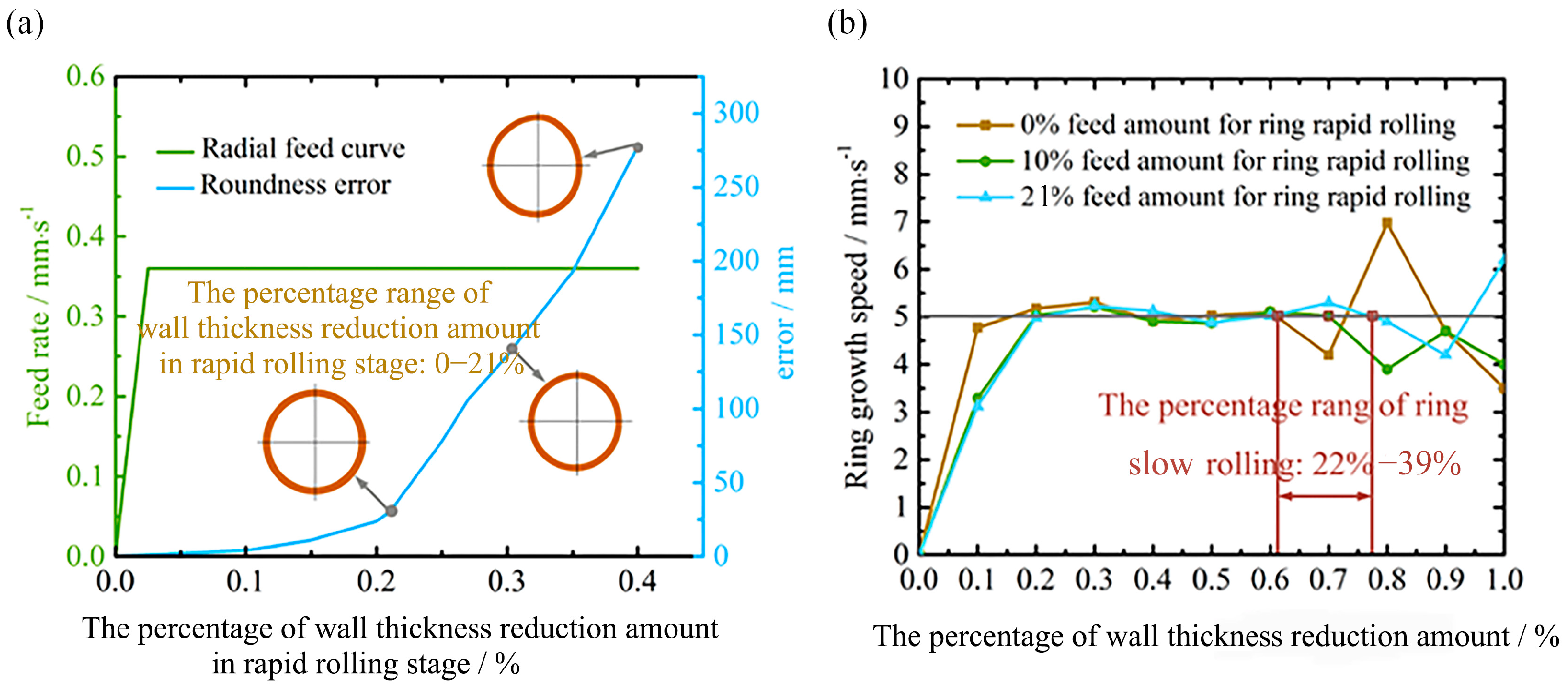
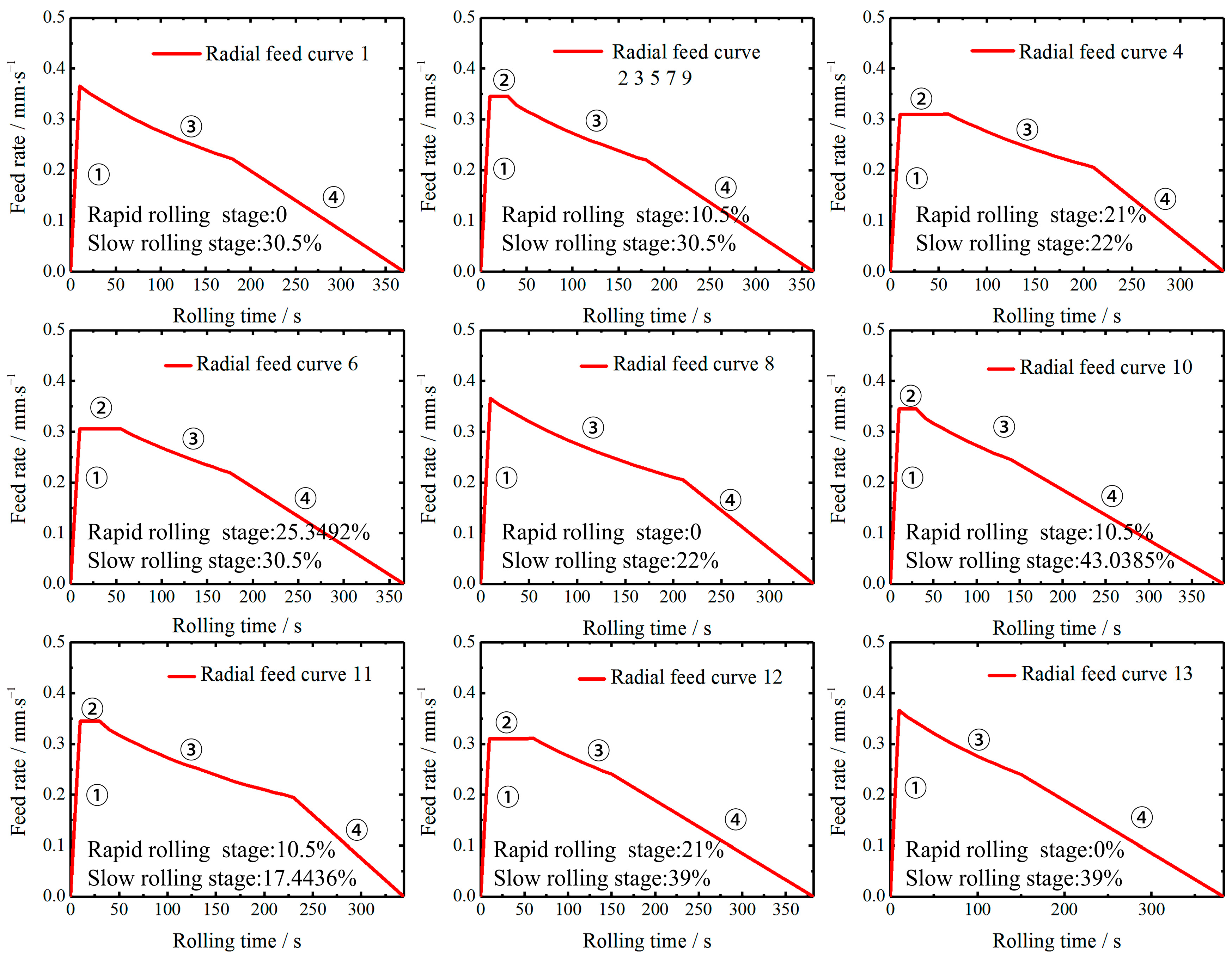
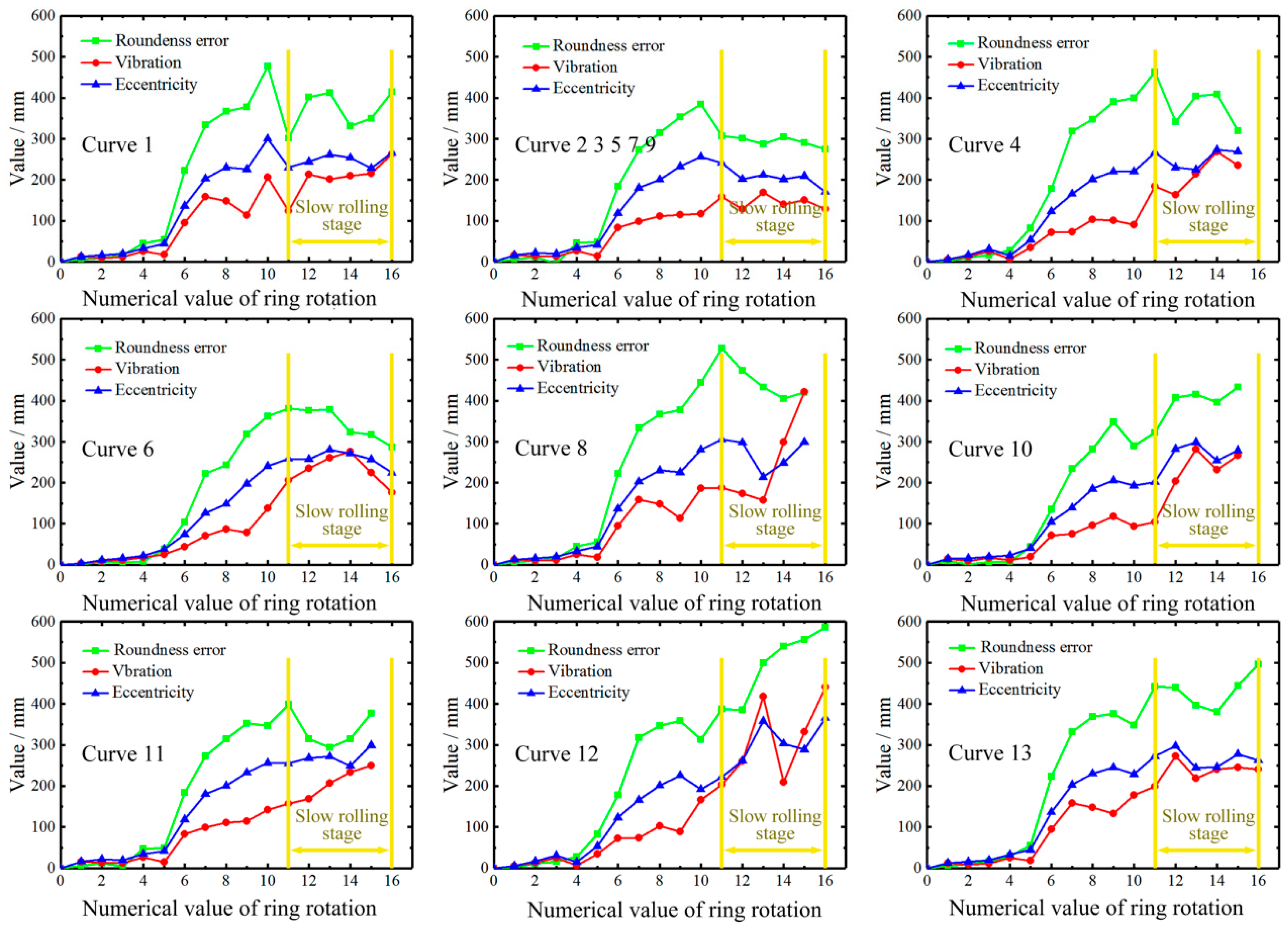




| Parameters | Values |
|---|---|
| Main roll speed (rad/s) | 1.0 |
| Radial feed curve | Determined by ring growth speed of 5 mm/s |
| Axial feed amount (mm) | 0 |
| Friction coefficient | 0.3 |
| Initial billet temperature (°C) | 500 |
| Initial rolls temperature (°C) | 150 |
| Ring billet parameter (mm) | Φ3600 × Φ3000 × 500 |
| Ring forging parameter (mm) | Φ5030 × Φ4820 × 500 |
| Implement | Production Trial | |||||
|---|---|---|---|---|---|---|
| Group1 | Group2 | Group3 | Group4 | Group5 | Group6 | |
| Diameter (mm) | 5037 | 5028 | 5047 | 5066 | 5053 | 5037 |
| Determination accuracy | 0.0029% | −0.0019% | 0.0022% | 0.0028% | 0.0014% | −0.0018% |
| Implement | Production Trial | Numerical Simulation | Relative Error |
|---|---|---|---|
| Roundness error (mm) | 38 | 31 | −18.42% |
| Eccentricity (mm) | 25 | 22 | −12.00% |
| Vibration (mm) | 13 | 12 | −7.69% |
| Object | Production Trial | Numerical Simulation | Requirement |
|---|---|---|---|
| Machining amount (mm) | 38 | 31 | ≤40 |
Disclaimer/Publisher’s Note: The statements, opinions and data contained in all publications are solely those of the individual author(s) and contributor(s) and not of MDPI and/or the editor(s). MDPI and/or the editor(s) disclaim responsibility for any injury to people or property resulting from any ideas, methods, instructions or products referred to in the content. |
© 2023 by the authors. Licensee MDPI, Basel, Switzerland. This article is an open access article distributed under the terms and conditions of the Creative Commons Attribution (CC BY) license (https://creativecommons.org/licenses/by/4.0/).
Share and Cite
Xie, D.; Ouyang, Q.-y.; He, L.-y.; Xu, W.-j. Feed Curves for Controlling Ring Rolling Stability in Large-Scale Flat Ring Rolling Process. Materials 2023, 16, 3383. https://doi.org/10.3390/ma16093383
Xie D, Ouyang Q-y, He L-y, Xu W-j. Feed Curves for Controlling Ring Rolling Stability in Large-Scale Flat Ring Rolling Process. Materials. 2023; 16(9):3383. https://doi.org/10.3390/ma16093383
Chicago/Turabian StyleXie, Dan, Qiu-yue Ouyang, Luo-yu He, and Wu-jiao Xu. 2023. "Feed Curves for Controlling Ring Rolling Stability in Large-Scale Flat Ring Rolling Process" Materials 16, no. 9: 3383. https://doi.org/10.3390/ma16093383
APA StyleXie, D., Ouyang, Q.-y., He, L.-y., & Xu, W.-j. (2023). Feed Curves for Controlling Ring Rolling Stability in Large-Scale Flat Ring Rolling Process. Materials, 16(9), 3383. https://doi.org/10.3390/ma16093383





